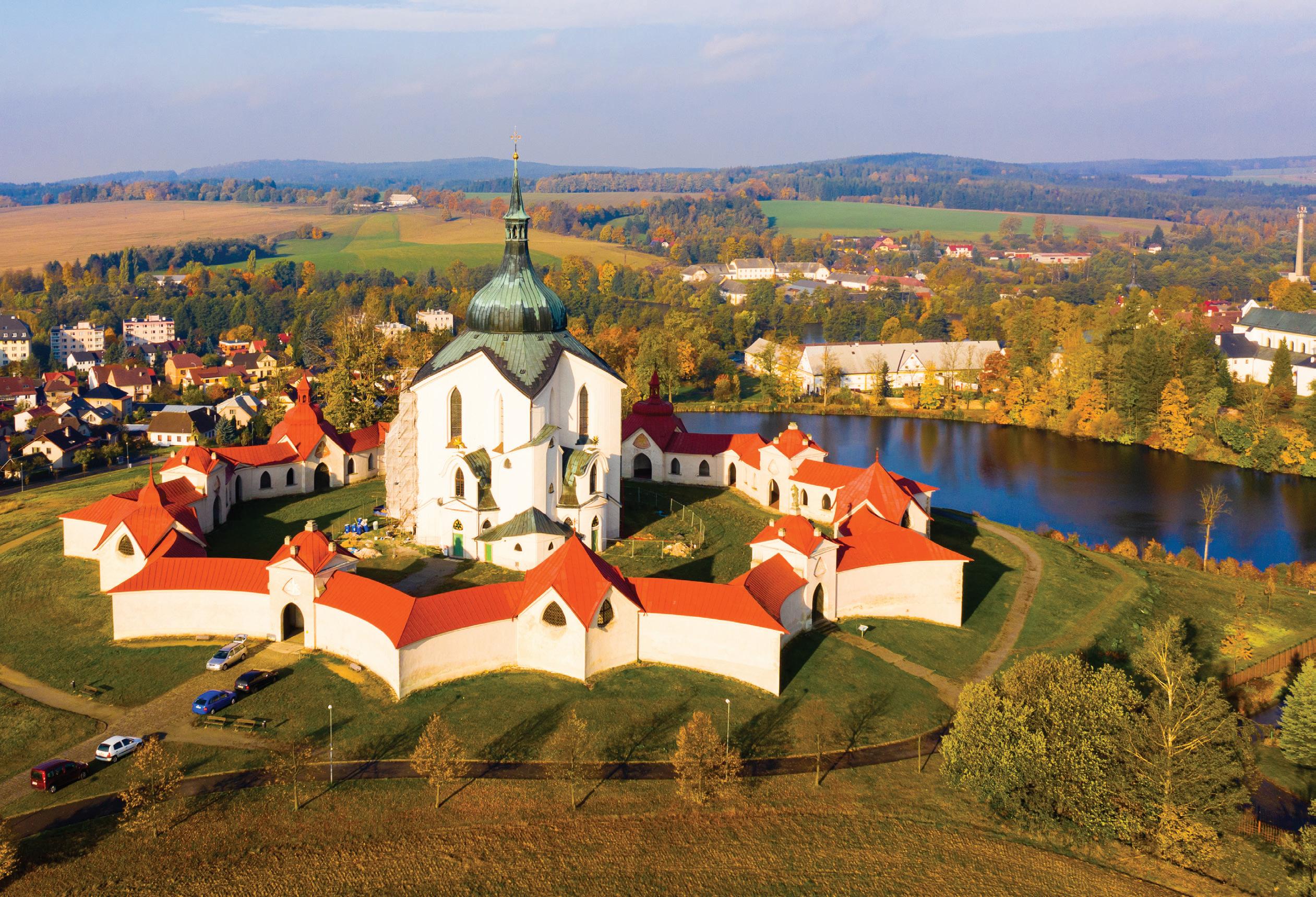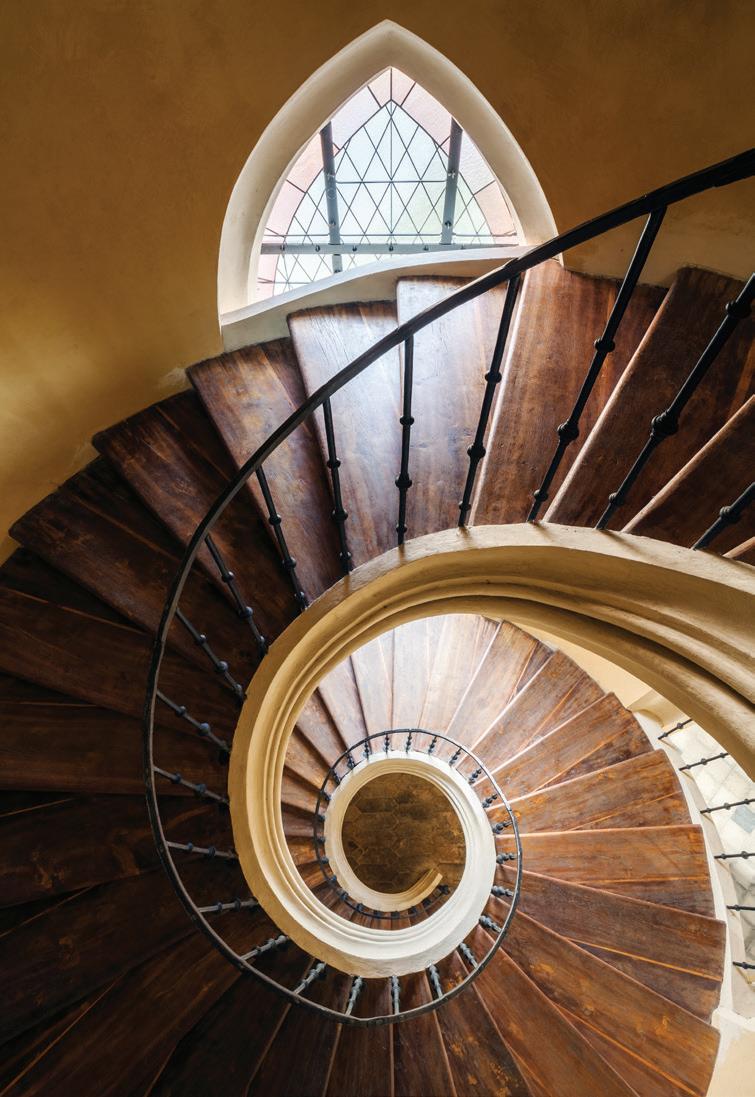
5 minute read
Star Appeal
By Janice Tober
Meet the architect who shaped some of the Czech Republic’s grandest Baroque attractions
Prague is considered one of the world’s most beautiful cities. Its Baroque buildings, bridges and basilicas create a postcard-perfect backdrop for a labyrinth of picturesque squares and stunning architecture.
But outside of Prague, several UNESCO World Heritage sites show the very best of Baroque design, created by one of the country’s greatest architects – Jan Blažej Santini-Aichel. In the Czech Republic, he is the 18th-century version of a modern-day ‘starchitect’ on par with talents like Frank Gehry and Moshe Safdie.
The Czech Republic began its third architectural renaissance in the 1600s, reaching its peak in the early 1700s. After the country’s loss at the Battle of White Mountain, Baroque architecture dominated, spilling to the towns and cities outside of the capital.
Italian architects like Carlo Lurago may be known for grand Baroque buildings like the Klementinum in Prague, but it is Santini who emerged as a visionary, the man behind Czech Baroque Gothic. Known for creating structures incorporating mysticism and symbolism, Santini was considered a maverick in the world of architecture. And he became popular because of it.
ŽĎÁR NAD SÁZAVOU
About two hours from Prague, you’ll find Žďár nad Sázavou, a pretty town with some of Santini’s best work. Abbott Václav Vejmluva invited the architect to give a modern makeover to the town by designing a new church, a cemetery, a horse stable, an inn and a hospital. It really is the town that Santini built.
First on our must-see list is the New Generation Museum, a stunning gallery dedicated, in part, to Santini himself, built on the site of a 13th-century Cistercian monastery turned castle. Begin your visit by travelling back in time. Walk by the holograms depicting the dark forest where medieval monks constructed the monastery centuries ago. Then you’ll enter the Baroque era through dreamlike interactive exhibits that bring to life the world as Santini saw it.

The Pilgrimage Church of St. John of Nepomuk in Žďár nad Sázavou
Next, head to what is considered his greatest accomplishment, the Pilgrimage Church of St. John of Nepomuk. Built between 1719 and 1727, what you may not notice unless you have the gift of flight is that the church complex is made in the shape of a star, a pattern replicated throughout the church interior.
This UNESCO site is an unpretentious beauty. You can see Santini’s sure hand in creating a place of contemplation. Pure white walls are complemented by off-white plasterwork containing filigree-like detail, letting the altar – laden with ornate angels and a globe of stars – be the ‘star’ that attracts your attention. Gothic elements include the vaulted ribbed ceiling featuring a golden star within a star.
ŽELIV
Next on your Santini-centric tour is the Premonstratensian Monastery Church of the Nativity of the Virgin Mary, located an hour from either Prague or Žďár nad Sázavou.

The Premonstratensian Monastery in Želiv, with a brewery on site
©Czech Tourism/Jakub Frey
After the original church burned down in 1712, Santini was invited to Želiv to build the new church. Here, too, the architect incorporated his Gothic aesthetic into a Baroque masterpiece. Far more colour was used in this design, but still, we see Santini’s classic white walls paired with a fanciful altar, plus evocative statuary and paintings. While this church is not a UNESCO site, it is a national historic site and one worth seeing, especially with the brewery on site.
The first mention of beer making at the monastery was in the 14th century and, today, brewmasters still brew the beer in the old way – unpasteurized and unfiltered. It’s delicious. Tours, tastings and longer brewing courses are offered.
POSTUPICE
Taking a break from churches, we visit Chateau Jemniště. This chateau was designed by architect František Maxmilián Kaňka in High Baroque style and, unlike the refined work of our man Jan Santini, it is over-the-top with decoration, colour and florid décor details. Jemniště is considered one of the most authentically preserved Baroque chateau complexes in the Czech Republic, so give your eyes a workout and take in its splendour.

Chateau Jemniště
©Czech Tourism/Vaclav Bacovsky
KUTNÁ HORA
While the Nepomuk church may be Santini’s most famous work, Kutná Hora is the “it” town to see both Czech Baroque and Gothic architecture. It was once home to royals, silver mines and a mint that ensured the city’s wealth.
In the Sedlec neighbourhood, the UNESCO-designated Cathedral of the Assumption of Our Lady and St. John the Baptist is said to be a triumph of Santini’s Baroque Gothic style. Built in 1709, it shows more Gothic details than Santini’s other work, particularly in the use of rib vaulting and pointed-arch windows. But you still see Santini’s distinctive touches – the use of white and earthy sand colours and his selective use of deeper hues and gold gilding. Of course, the architect’s love of star imagery can also be seen in the marble black and white floor.

Santini’s Baroque aesthetic is on display even in staircases
©Czech Tourism/Martin Rak
Though chilling, one of the most thrilling parts of visiting this cathedral is stopping at the nearby ossuary of the Cemetery Church of All Saints. This crypt is piled with skulls, skulls and more skulls, but neither stacked in haphazard groupings, nor neatly arranged row by row as if in a 19th-century medical mortuary. No. These bones were used to create creepily ornate chandeliers, coats-of-arms, vases and candlesticks. The crypt’s nearly 4,000 inhabitants consist of victims from wars and plagues. Once you get over the ick factor, you can actually see the strange magnificence of this unusual display.

Town of Kutná Hora
©Czech Tourism/Michal Vitásek
Once you’ve made the rounds of only a few of the architectural marvels in the Czech Republic, make the journey back to Prague. Once there, you only have to look around you to see the work of Jan Santini and other Baroque masters, particularly beautiful in the golden light at dusk. But while the sun begins to fade, the legacy of the Czech Republic’s most-celebrated star architect will continue to shine brightly.










